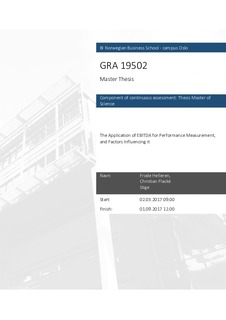The application of EBITDA for performance measurement, and factors influencing it
Master thesis
Permanent lenke
http://hdl.handle.net/11250/2484093Utgivelsesdato
2017Metadata
Vis full innførselSamlinger
- Master of Science [1621]
Sammendrag
This thesis is based on firm observations from Oslo Børs in the period from 2011
to 2015, and studies the use of EBITDA in the firms’ annual reports and if there
are any factors influencing this use.
We apply the modified Jones model to estimate earnings management through
accruals, and use this to generate a variable for earnings management which we
insert into a multiple linear regression model for measuring the use of EBITDA.
However, we found inconclusive results about earnings management and the use
of EBITDA.
Further, we examine other factors that we expected to have an influence on
EBITDA. We found evidence that firm size and decreasing cash flow were
significantly different from zero at the 1% level (99% confidence interval) and
10% level (90% confidence interval) respectively, suggesting that these variables
do affect the use of EBITDA in the annual reports. The remaining factors did not
provide any evidence towards the use of EBITDA in the annual reports (financial
reporting). However, we assess the tendencies in conjunction with our hypotheses
regarding prior expectations. Furthermore, we see that the different sectors
explain approximately 10% of the total variation in the regression model.
We experience that the use of EBITDA or other pro forma earnings measures vary
between firms but also for a firm from year to year. Further, it is unclear what
EBITDA contains, making it difficult to interpret and compare with other firms’
EBITDA.
Beskrivelse
Masteroppgave(MSc) in Master of Science in Business, Business law, tax and accounting - Handelshøyskolen BI, 2017
